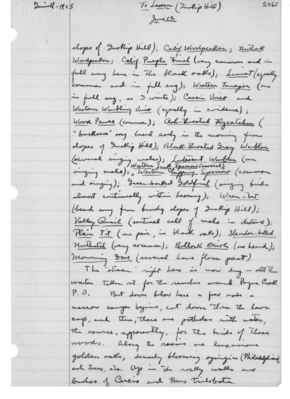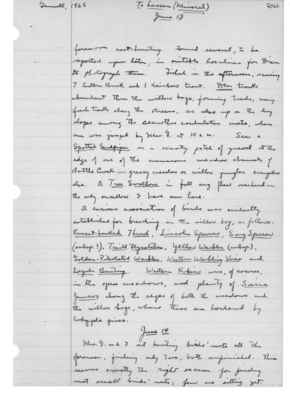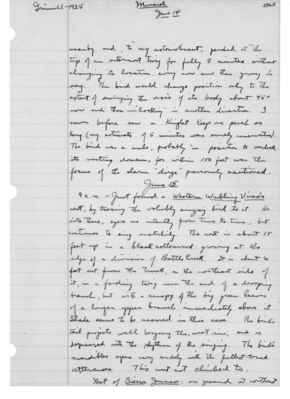Pages That Mention Western Warbling Vireo
1925: Joseph Grinnell's field notes
S2 Page 4
Collector: Grinnell - 1925 Location: Lassen Section Date: June 12, 1925 Page Number: 2460
slopes of Inskip Hill); Calif. Woodpecker; Nuttall Woodpecker; Calif. Purple Finch (very common and in full song here in the black oaks); Linnet (equally common and in full song); Western Tanager (one in full song, as I write); Cassins Vireo and Western Warbling Vireo (equally in evidence); Wood Pewee (common); Ash-Throated Flycatcher ( "buckaroo" song heard early in the morning from slopes of Inskip Hill; Black-Throated Gray Warbler (several singing males); Lutescent Warbler (one singing male) Western Lark Sparrow (several); Western Chipping sparrow (common and singing); Green-backed Goldfinch (singing birds almost continually within hearing); Wren-tit (heard song from bushy slopes of Inskip Hill; Valley Quail (sentinel call of male in distance); Plain Tit (one pair, in black oaks); Slender-billed Nuthatch (very common); Bullock Oriole (one heard); Morning Dove (several have flown past); The "stream" right here is now dry - all the water taken out for the ranches around Payne Creek P.O. But down below here a few rods a narrow canyon begins, cut down thru the lava cap, and there, there are potholes with water, the source, apparently, for the birds of these woods. Along the ravine are luxurious golden oaks, densely blooming syringia (Philadelphus), ash trees, etc. Up in the rocky walls are bushes of Cercis and Rhus Trilobata.
S2 Page 6
Collector: Grinnell - 1925 Location: Lassen Section (Mineral) Date: June 13-14, 1925 Page Number: 2462
forenoon nest-hunting. Found several, to be reported upon later, in suitable locations for Dixon to photograph them. Fished in the afternoon, securing 7 Eastern Brook and 1 Rainbow Trout. Deer tracks abundant thru the willow bogs, forming trails; many fresh tracks along the streams, as also up on the dry slopes among the Ceanothus cordulatus mats, where one was jumped by Mrs. G at 10 a.m. Saw a Spotted Sandpiper on a scanty patch of gravel at the edge of one of the numerous meadow channels of Battle Creek - grassy meadows on willow jungles everywhere else. A Tree Swallow in full song flew overhead - the only swallow I have seen here. A curious association of birds was evidently established for birding in the willow bog, as follows: Russet-backed Thrush, Lincoln Sparrow, Song Sparrow (subsp.?), Traill Flycatcher, Yellow Warbler (subsp.), Golden-Pileolated Warbler, Western Warbling Vireo and Lazuli Bunting. Western Robins were, of course, in the open meadows, and plenty of Sierra Juncos along the edges of both the meadows and the willow bogs, where these are bordered by lodgepole pines. June 14 Mrs. G. and I out hunting birds' nests all the forenoon, finding only two, both unfinished. This seems exactly the right season for finding most small birds' nests; few are sitting yet.
S2 Page 9
Collector: Grinnell - 1925 Location: Lassen Section (Mineral) Date: June 14-15, 1925 Page Number: 2465
nearby and, to my astonishment, perched at the top of an outermost twig for fully 5 minutes without changing its location, every now and then giving its song. The bird would change position only to the extent of swinging the axis of its body about 45° now and then - "looking" in another direction. I never before saw a Kinglet keep one perch so long (my estimate 15 minutes was surely conservative). The bird was a male, probably in position to overlook its nesting domain, for within 100 feet was the focus of the alarm "dinge" previously mentioned. June 15 9 a.m. - Just found a Western Warbling Vireo's nest, by tracing the volubly singing bird to it. He sits there, eyes me intently from time to time, but continues to sing snatchily. The nest is about 18 feet up in a black cottonwood growing at the edge of a division of Battle Creek. It is about 6 feet out from the trunk, on the northeast side of it, in a forking twig near the end of a drooping branch, but with a canopy of the big green leaves of a longer upper branch immediately above it. Shade seems to be assured in this case. The birds' tail projects well beyond the nest rim, and is depressed with the rhythm of the singing. The birds' mandibles open very widely with the fullest-toned utterances. This nest not climbed to. Nest of Sierra Junco: on ground at northeast.


